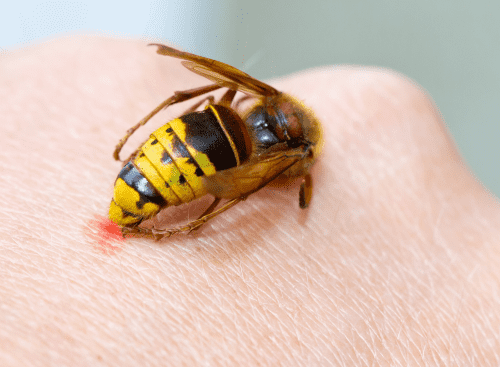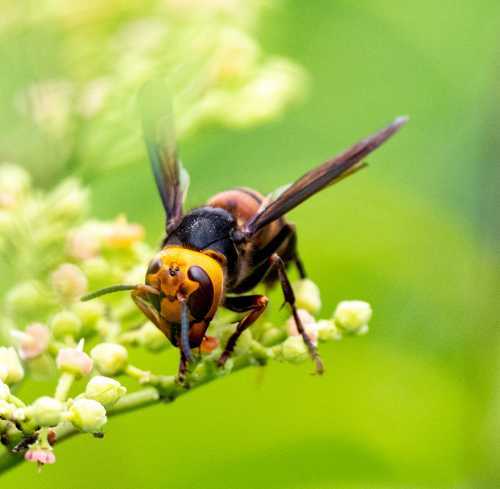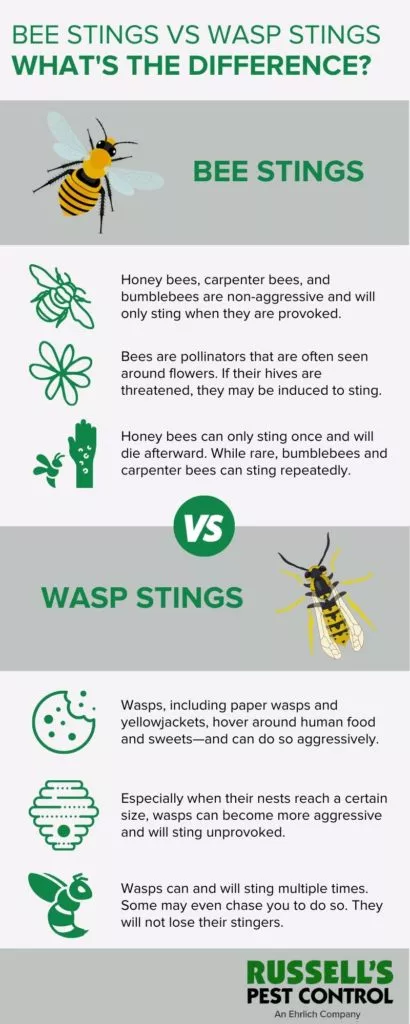Which stings are the most dangerous to humans, and do bees, wasps and hornets sting each other?
Is A Wasp Sting The Same As A Bee Sting
According to one scientific paper, of the sample studied, 2 species of wasp delivered the most painful stings, and both were tarantula hawk wasps, yet their stings were also the least venomous.
A paper wasp, Polistes infuscatus had the most toxic venom. The yellowjackets, honey bees and bumble bees included in the study appeared about mid-way in both tables. Most solitary bee species delivered low-pain stings that were among the least venomous.
Bee Vs Wasp Vs Hornet Stings: A Comparison

If you have read my page ‘Bees vs Hornets’, you may be wondering how a hornet sting would compare with a bee sting, and where wasps such as yellow jackets fit into the equation in relation to sting pain and lethality (toxicity) of venom.
It so happens that we do have at our disposal, some data that will help to answer this question, at least for some species. The data comes from an entomologist called Justin O. Schmidt, (author of Sting Of The Wild), who published a paper in 2019: Pain and Lethality Induced by Insect Stings1.
In the study, the painfulness of stings of 96 species of stinging insects and the lethalities of the venoms of 90 species were assessed, and some of those insect species were bees, wasps and hornets.
The data for those species has been extracted and is presented here, along with an explanation. Full tables appear further down the page, but for now, let us consider the species occupying the top 3 slots for pain level and venom toxicity.
(Note that despite the name, ‘velvet ants’ are in fact, wasp species).
| Rank | Most Painful Sting | Most Toxic Venom |
|---|---|---|
| 1 | Synoeca septentrionalis (warrior wasp), Pepsis grossa (tarantula hawk wasp), Pepsis thisbe (tarantula hawk wasp). Pain score: 4 |
Polistes infuscatus (paper wasp).
LD50 (mg/kg): 1.3 |
| 2 | Polistes infuscatus (paper wasp), Polistes erythrocephalus (paper wasp), Polistes canadensis (paper wasp), Polistes tepidus (paper wasp), Polistes annularis (paper wasp), Dasymutilla klugii (cow killer velvet ant). Pain score: 3 |
Brachygastra mellifica (honey wasp), Polistes erythrocephalus (paper wasp). LD50 (mg/kg): 1.5 |
| 3 | Polybia simillima (polybia wasp), Agelaia myrmecophila (fire wasp), Provespa sp. (nocturnal hornet), Xylocopa sp. (giant Bornean bee). Pain score: 2.5 |
Polistes instabilis (paper wasp), Vespa luctuosa (hornet). LD50 (mg/kg): 1.6 |
In general, what we can already see from this data, are the following points:
-
- an insect species having the most painful sting, does not necessarily have the most toxic sting. For example, the tarantula hawk wasps which apparently deliver a very painful sting, are not ranked within the top 3 for venom toxicity (they actually had among the least toxic venom of all the bees, wasps and hornets in the sample).
- Most of the species appearing in each category (pain and toxicity), are wasps.
- A hornet species ranks in both the top 3 for sting pain and venom toxicity, although they are different species.
- There are no bee species ranked in the top 3 for venom toxicity, although a Xylocopa species (large carpenter bee) is ranked within the top 3 for sting pain.
- Not all wasp and hornet and bee stings are the same, with some being more painful and slightly more toxic than others.
Is this the whole story with regard to sting pain?
Probably not, and there are some limitations with the data. For example:
- Some species that were analyzed for venom toxicity were not assessed for pain, such as the Asian giant hornet, Vespa mandarinia.
- It’s worth remembering that although the sample is a large one, there are thousands and thousands of bee, wasp and hornet species, so the comparison is not complete.
- Although, for example, the honey bees were discovered to have more toxic venom than the Asian giant hornet, Vespa mandarinia, it’s worth remembering that honey bees can only sting once, where as the hornet can sting multiple times. In addition, a single Vespa mandarinia sting can deliver 10 times the venom than is ejected from the sting of a honey bee, and this is a point the author of the study makes himself (see my comparison of bee and hornet venom).
 Asian giant hornet, Vespa mandarinia
Asian giant hornet, Vespa mandariniaIf you would like to know more about this research and the species compared (including honey bees and yellowjackets), please read on. Otherwise, you might be interested to learn where stings hurt most.
Which Stings Hurts Most?
A Comparison Of Pain From Bee, Wasp And Hornet Stings
In Schmidt’s paper, pain level was graded between 1 and 4, with the score 4 allocated to the most painful stings.
Of the 58 wasp, hornet and bees species tested, the 3 most painful are highlighted in the table above.
After that, most of the remaining social wasps had a pain score of 2, including those commonly referred to as yellowjackets (both Vespular vulgaris and Vespular germanica). They shared this score with the baldfaced hornet, Dolichovespula maculata, the honey bees, the bumble bees, and two further solitary bee species (both Xylocopa).
Although wasp species had the most painful stings, it was a solitary wasp, Sapyga pumila (club-horned wasp) that had the least painful sting of all, along with two solitary bee species (Triepeolus sp. (cuckoo bee) and Dieunomia heteropoda (giant sweat bee) all sharing a score of 0.5.
| Species | Insect Type | Sting Pain Score | Pain Level |
|---|---|---|---|
| Synoeca septentrionalis (warrior wasp) |
Social Wasp | 4 | Most Painful Sting |
| Pepsis grossa (tarantula hawk wasp) |
Solitary Wasp | 4 | |
| P. thisbe (tarantula hawk wasp) |
Solitary Wasp | 4 | |
| P. infuscatus (paper wasp) |
Social Wasp | 3 | |
| P. erythrocephalus (paper wasp) |
Social Wasp | 3 | |
| P. canadensis. (paper wasp) |
Social Wasp | 3 | |
| P. tepidus (paper wasp) |
Social Wasp | 3 | |
| P. annularis (paper wasp) |
Social Wasp | 3 | |
| D. klugii (cow killer velvet ant) |
Solitary Wasp | 3 | |
| P. simillima (polybia wasp) |
Social Wasp | 2.5 | |
| Agelaia myrmecophila (fire wasp) |
Social Wasp | 2.5 | |
| Provespa sp. (nocturnal hornet) |
Hornet | 2.5 | |
| Xylocopa sp. (giant Bornean bee) |
Solitary Bee | 2.5 | |
| B. juncea colonialis (fire-tail wasp) |
Social Wasp | 2 | |
| Brachygastra mellifica (honey wasp) |
Social Wasp | 2 | |
| Vespula germanica (yellowjacket wasp) |
Social Wasp | 2 | |
| V. vulgaris (yellowjacket wasp) |
Social Wasp | 2 | |
| V. pensylvanica (yellowjacket wasp) |
Social Wasp | 2 | |
| Polistes instabilis (paper wasp) |
Social Wasp | 2 | |
| P. arizonicus (paper wasp) |
Social Wasp | 2 | |
| Parachartergus fraternus (artistic wasp) |
Social Wasp | 2 | |
| Dolichovespula maculata (baldfaced hornet) |
Hornet | 2 | |
| D. arenaria (aerial yellowjacket) |
Social Wasp | 2 | |
| Mischocyttarus sp. (a paper wasp) |
Social Wasp | 2 | |
| A. mellifera (honey bee) |
Social Bee | 2 | |
| A. dorsata (giant honey bee) |
Social Bee | 2 | |
| A. cerana (Eastern honey bee) |
Social Bee | 2 | |
| Bombus impatiens (bumble bee) |
Social Bee | 2 | |
| B. sonorus (bumble bee) |
Social Bee | 2 | |
| Xylocopa rufa (nocturnal carpenter bee) |
Solitary Bee | 2 | |
| X. californica (carpenter bee) |
Solitary Bee | 2 | |
| D. gloriosa (velvet ant) |
Solitary Wasp | 2 | |
| P. rejecta (polybia wasp) |
Social Wasp | 1.5 | |
| Belonogaster sp. (thin paper wasp) |
Social Wasp | 1.5 | |
| Apis florea (dwarf honey bee) |
Social Bee | 1.5 | |
| Euglossa dilemma (orchid bee) |
Solitary Bee | 1.5 | |
| S. grandis (cicada killer wasp) |
Solitary Wasp | 1.5 | |
| Mutillidae sp. (small nocturnal velvet ant) |
Solitary Wasp | 1.5 | |
| Polybia occidentalis (polybia wasp) |
Social Wasp | 1 | |
| Ropalidia flavobrunnea | Social Wasp | 1 | |
| Ropalidia sp. | Social Wasp | 1 | |
| Xenoglossa angustior (squash bee) |
Solitary Bee | 1 | |
| Habropoda pallida (white-faced bee) |
Solitary Bee | 1 | |
| Diadasia rinconis (cactus bee) |
Solitary Bee | 1 | |
| Emphoropsis pallida | Solitary Bee | 1 | |
| Lasioglossum spp. (sweat bee) |
Solitary Bee | 1 | |
| Ericrocis lata (cuckoo bee) |
Solitary Bee | 1 | |
| Eumeninae spp. (potter wasps) |
Solitary Wasp | 1 | |
| Sphecius convallis (cicada killer wasp) |
Solitary Wasp | 1 | |
| Sphex pensylvanicus (great black wasp) |
Solitary Wasp | 1 | |
| Chlorion cyaneum (cockroach-hunter wasp) |
Solitary Wasp | 1 | |
| Triscolia ardens (scarab-hunter wasp) |
Solitary Wasp | 1 | |
| Sceliphron caementarium (mud dauber wasp) |
Solitary Wasp | 1 | |
| Euodynerus crypticus (water walking wasp) |
Solitary Wasp | 1 | |
| Dasymutilla thetis (little velvet ant) |
Solitary Wasp | 1 | |
| Dieunomia heteropoda (giant sweat bee) |
Solitary Bee | 0.5 | Least Painful Sting |
Which Stings Are Most Toxic?
A Comparison Of Venom Toxicity From Bee, Wasp And Hornet Stings
In the study, 50 bee, wasp and hornet species were assessed for the level of sting toxicity.
In making his comparison, Schmidt used a measure known as LD50 (also commonly used in assessing the lethality of insecticides).
LD50 is the quantity required to kill 50 percent of test subjects, and in this case, those subjects were mice. The less venom required for a lethal (killing), the more dangerous and toxic the substance.
Yellowjackets (three species) had a venom toxicity level comparable with three different honey bee species (including Apis mellifera, Apis dorsata, and Apis florea) and the hornet, V. tropica.
| Species | Insect Type | LD50 (mg/kg) | Toxicity Level |
|---|---|---|---|
| P. infuscatus (paper wasp) |
Social Wasp | 1.3 | Most toxic venom |
| Brachygastra mellifica (honey wasp) |
Social Wasp | 1.5 | |
| P. erythrocephalus (paper wasp) |
Social Wasp | 1.5 | |
| Polistes instabilis (paper wasp) |
Social Wasp | 1.6 | |
| Vespa luctuosa (hornet) |
Hornet | 1.6 | |
| P. arizonicus (paper wasp) |
Social Wasp | 2 | |
| P. canadensis. (paper wasp) |
Social Wasp | 2.4 | |
| V. vidua (yellowjacket wasp) |
Social Wasp | 2.6 | |
| Vespula germanica (yellowjacket wasp) |
Social Wasp | 2.8 | |
| V. consobrina (yellowjacket wasp) |
Social Wasp | 2.8 | |
| V. tropica (hornet) |
Hornet | 2.8 | |
| Apis florea (dwarf honey bee) |
Social Bee | 2.8 | |
| A. mellifera (honey bee) |
Social Bee | 2.8 | |
| A. dorsata (giant honey bee) |
Social Bee | 2.8 | |
| B. juncea colonialis (fire-tail wasp) |
Social Wasp | 3 | |
| Synoeca septentrionalis (warrior wasp) |
Social Wasp | 3 | |
| V. simillima (hornet) |
Hornet | 3.1 | |
| A. cerana (Eastern honey bee) |
Social Bee | 3.1 | |
| P. simillima (polybia wasp) |
Social Wasp | 4.1 | |
| V. mandarinia (giant hornet) |
Hornet | 4.1 | |
| Polybia occidentalis (polybia wasp) |
Social Wasp | 5 | |
| Parachartergus fraternus (artistic wasp) |
Social Wasp | 5.3 | |
| V. vulgaris (yellowjacket wasp) |
Social Wasp | 5.4 | |
| Agelaia myrmecophila (fire wasp) |
Social Wasp | 5.6 | |
| Ropalidia flavobrunnea | Social Wasp | 5.9 | |
| P. sericea (polybia wasp) |
Social Wasp | 6.1 | |
| Dolichovespula maculata (baldfaced hornet) |
Hornet | 6.1 | |
| V. pensylvanica (yellowjacket wasp) |
Social Wasp | 6.4 | |
| P. tepidus (paper wasp) |
Social Wasp | 7.7 | |
| D. arenaria (aerial yellowjacket) |
Social Wasp | 8.7 | |
| Ropalidia sp. | Social Wasp | 10 | |
| P. annularis (paper wasp) |
Social Wasp | 11 | |
| Bombus impatiens (bumble bee) |
Social Bee | 11 | |
| Xylocopa rufa (nocturnal carpenter bee) |
Solitary Bee | 11 | |
| B. sonorus (bumble bee) |
Social Bee | 12 | |
| Xenoglossa angustior (squash bee) |
Solitary Bee | 12 | |
| Apoica pallens (night wasp) |
Social Wasp | 13.5 | |
| Ropalidia (Icarielia) sp. | Social Wasp | 14 | |
| X. californica (carpenter bee) |
Solitary Bee | 14 | |
| P. rejecta (polybia wasp) |
Social Wasp | 16 | |
| Dieunomia heteropoda (giant sweat bee) |
Solitary Bee | 25 | |
| X. veripuncta (carpenter bee) |
Solitary Bee | 33 | |
| S. grandis (cicada killer wasp) |
Social Wasp | 46 | |
| Centris pallida (palo verde bee) |
Solitary Bee | 56 | |
| Crioscolia flammicoma (scoliid wasp) |
Social Wasp | 62 | |
| Habropoda pallida (white-faced bee) |
Solitary Bee | 70 | |
| D. klugii (cow killer velvet ant) |
Social Wasp | 70 | |
| Diadasia rinconis (cactus bee) |
Solitary Bee | 76 | |
| Pepsis grossa (tarantula hawk wasp) |
Solitary Wasp | 90 | |
| P. thisbe (tarantula hawk wasp) |
Solitary Wasp | 120 | Least Toxic Venom |
Is A Wasp Sting The Same As A Bee Sting
List Of Is A Wasp Sting The Same As A Bee Sting
Additional Info :
| Item Dimensions | |
| Height | 0.7 Inches |
| Width | 20 Inches |
| Length | 20 Inches |
| Weight | 48 ounces |
- One 0.5 fl oz StingEze Original Insect Bite Relief Dauber
- Pain reliever provides instant triple action relief to ease pain, itching and swelling while cleaning and disinfecting the area
- Insect bite treatment works on bites and stings from common insects, including bees, ticks, mosquitoes and fire ants
- Ammonia-free external analgesic formula uses benzocaine for effective relief
- Made with only four ingredients and comes in a convenient tube with a sponge dauber applicator for easy, precise use
Additional Info :
| Color | Black |
| Item Dimensions | |
| Height | 6.75 Inches |
| Width | 2.5 Inches |
| Length | 0.88 Inches |
| Weight | 0.03 Pounds |
| Release Date | 2018-07-01T00:00:01Z |
- 3.5-ounce tube of Benadryl Extra-Strength Cooling Itch Stopping Anti-Itch Gel for fast cooling relief from skin pain and itching from most outdoor itches
- Provides relief from most outdoor itches associated with insect bites, sunburn, scrapes, minor skin irritations, burns, and minor cuts
- Soothing anti-itch gel also provides relief from itching associated with rashes caused by poison ivy, poison oak, and poison sumac
- Cooling gel formula contains 2% of the topical analgesic pain reliever diphenhydramine hydrochloride that works by blocking histamines to relieve itches associated with several ailments
- Intended for use by those ages 2 and up, soothing gel offers itch relief for kids and adults alike and is great to keep on hand during outdoor activities such as camping, hiking or taking a walk with the family
Additional Info :
| Item Dimensions | |
| Height | 6.35 Inches |
| Width | 2.43 Inches |
| Length | 1.47 Inches |
| Weight | 3.5 ounces |
| Release Date | 2015-06-22T00:00:01Z |
- First aid analgesic to help prevent infection in and provide temporary relief of the pain of insect bites and stings, minor scrapes and minor burns
- Perfect for standalone first aid or as a refill for a kit
Additional Info :
| Item Dimensions | |
| Height | 4.1 Inches |
| Width | 0.8 Inches |
| Length | 2.3 Inches |
- DISINFECTING WIPES KILLS 99.9% OF VIRUSES AND BACTERIA: Lysol Disinfecting Wipes are tested and proven to clean and kill 99.9% of viruses and bacteria, including 8 cold and flu viruses* (when used as directed).
- KILLS COVID-19 VIRUS: Tested and proven to kill COVID-19 virus** (**Kills SARS-CoV-2 on hard, non-porous surfaces in 15 seconds), EPA Reg No.777-114.
- MULTI-PURPOSE CLEANING WIPES 3X STRONGER THAN A PAPER TOWEL: These disinfecting cleaning wipes are 3x stronger than a paper towel.
- USE ON MULTIPLE SURFACES: Germs and messes occur on more than kitchen and bathroom surfaces; conveniently tackle any tough surface including remotes, tablets, and smartphones with these multi-surface cleaning wipes.
- DISINFECTING WIPES FOR CLEANING: Disinfect and deodorize with the fresh smell of Lemon and Lime Blossom Lysol Disinfecting Wipes. Safely wipe down spills and remove allergens, including pet dander, dust mites, and pollen.
- LEADERS IN DISINFECTION: Looking for some of our other best disinfectant cleaning products? Try our Lysol All Purpose Cleaners, Lysol Disinfectant Sprays, and Lysol Toilet Cleaners.
Additional Info :
| Color | White |
| Item Dimensions | |
| Height | 8.5 Inches |
| Width | 16.5 Inches |
| Length | 4.13 Inches |
| Weight | 1 Pounds |
| Release Date | 2014-11-26T00:00:01Z |





